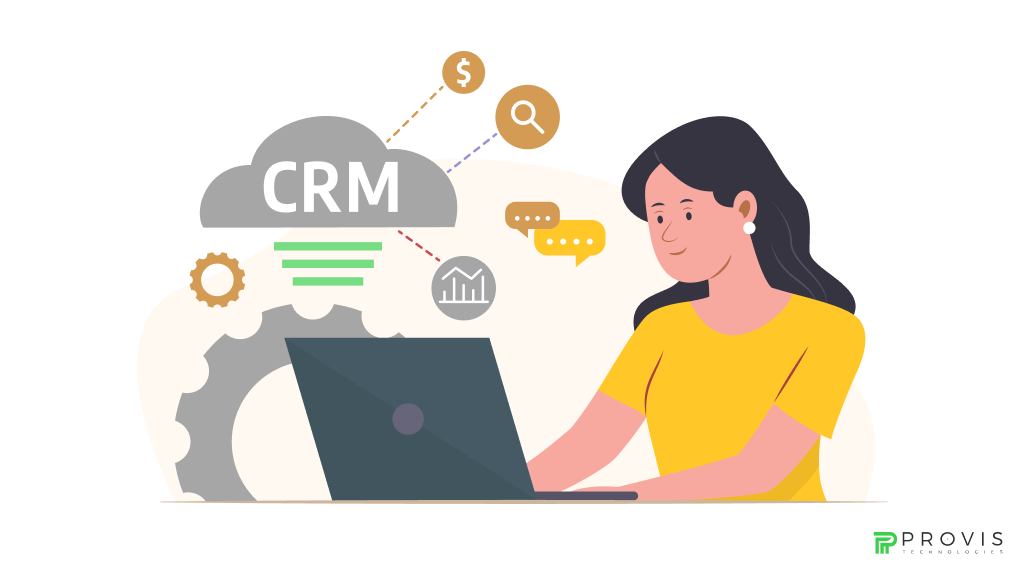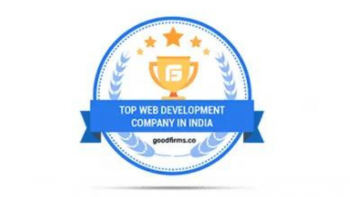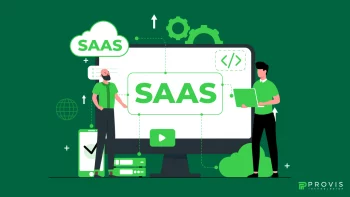Human resources is rapidly transforming with the advent of new technologies. By 2025, traditional tools and resources will no longer be effective for HR professionals as they seek smart, technological solutions.
This is where custom SaaS (Software as a Service) HR platforms come into play. They provide the capability to customize technology at will, ensuring optimal team performance. This blog post is intended to help you through the steps of building and refining a custom SaaS HR platform so that it meets the current and destined corporate environment.
Recommended reading: Software development trends to follow in 2025
What are the Benefits of a Custom SaaS HR Application?
Pre-packaged HR management software can be useful in some contexts, but it usually fails to meet specific business needs. With a custom SaaS platform, you can build exactly what you need, integrate it with the tools you already have in place, and allow it to grow with your company. It is like buying a suit off the rack compared to having one tailored. It just fits better.
A custom solution provides a level of flexibility that ready-made systems cannot provide, enabling you to meet the specific subtle details of your organization’s workflows and culture. This more systematic strategy assures that your HR technology becomes an asset that enhances efficiency and actively achieves the strategic goals of the business rather than a dependency that is futile and incomplete.
Here is a breakdown of the key advantages:
- Removes Compromises: Workarounds are no longer necessary. The custom platform resolves your company’s specific workflows, vocabulary, and culture.
- Flexibility and Scalability: Your SaaS HR system should be able to keep pace with your growing business. SaaS platforms are scalable by design, and their custom nature means that new features and functionality can easily be added.
- Integration: Effortlessly connect your HR platform to essential business tools such as payroll, accounting, and performance management systems. This enhances productivity by breaking down data silos and automating processes.
- Enhanced Security: Developing a custom platform offers you more control over data security and compliance, assuring that sensitive employee data is securely protected.
- Competitive Advantage: Efficient HR platforms can set you apart as a leader in the market because they attract and retain high-quality talent by providing an efficient modern employee experience.
Components of an HR SaaS Solution
An HR SaaS solution is more than just a set of features; it is a system that is designed to facilitate an employee’s lifecycle. Here are the primary features of a strong HR SaaS solution system:
Core HR Modules:
These features are necessary for every SaaS HR system. Imagine them as the most basic parts of your system. Some examples are:
Employee Database: This serves as a single repository for all employees’ personal information and employment history. The database works as the single point of truth when it comes to any employee-related queries, ensuring accuracy and consistency. It holds personal and professional information for each employee, such as their contact details, employment history, performance evaluations, and salary information. This structured database plays a key role in effective human resource management and provides the basis for all other HR modules.
Management of payroll: Automating calculations of salaries, tax withholding, and generation of pay slips. Payment provider integration is often regarded as essential. The automation of payroll processes is surely one of the most complicated portions of any HR solution; it requires accuracy and efficiency. Your paid HR solution integrated with payment providers simplifies the payroll mechanism and makes certain that employees receive their payments precisely when they are due. Mistakes are also less likely to occur, and compliance with payment laws is guaranteed.
Administration of benefits: Managing employee benefits programs in health care, pensions, and leave policy. As with all other processes, benefit administration is likely to be complicated, involve many actions, and be time-consuming, but modern platforms of HR technology can perform many of these activities. These include not only the enrollment processes but also tracking together with reports on expenses for the employee’s benefits. An adequate system designed to handle the administration of employee benefits will greatly improve efficiency while providing employees with the information they need.
Compliance Tracking: Streamlining the methodology for adhering to laws and minimizing exposure to risks and legal issues. Compliance with labor laws and regulations is an important component of human resource management, and this does not have to concern you if you have a good HR platform. The tracking system can monitor compliance, track changes in regulations, provide alerts about deadlines, and generate compliance reports. This is helpful not only to reduce the risk of legal issues but also to ensure that the HR practices are in accordance with the laws.
Talent Management Suite:
These modules are about acquiring, developing, and keeping the best employees in the organization. They enable the building of a better-performing organization. Some are:
Recruitment and Onboarding: Improving the hiring process from a job posting to an onboarding process. Recruitment and onboarding are essential to attracting and onboarding the best talent to an organization. An excellent SaaS HR system will be able to automate several elements of the recruitment process, including advertising job openings, resume screening, interview scheduling, and onboarding. The system should also ensure that new employees are well-prepared to succeed in their new positions.
Performance Management: Determines goals, analyzes performance, gives feedback, and actively manages performance. Managers ensure that employees are set specific organizational targets and employees are provided feedback about their performance. A SaaS HR system makes the process easier by providing the necessary instruments for goal setting, performance evaluation, and employee follow-up. It can also give an avenue for managers to give feedback and coaching to their staff.
Learning and Development: Allocating and Follow-Up of Employee’s Training Activities and Other Development Programs. Nurturing employees’ learning and development is vital in creating an overall competent and responsive workforce. An HR platform can enable you to control employee courses, track progress, and supervise other development possibilities. An automated system can also provide online learning materials and facilitate interaction between learners and their course instructors.
Succession Planning: Anticipating leadership gaps and preparing for them by fostering potential leaders within the organization. Carrying out succession planning becomes paramount when it comes to maintaining the leadership of your organization. An HR platform will facilitate the identification of dependable employees, monitor their development, and prepare succession plans for important leadership responsibilities. This guarantees that there is a flow of competent people to fill leadership positions that become vacant with time.
Workforce Management Tools:
They assist you with optimizing your workforce and managing employee time. Some include:
Time and Attendance Tracking: This includes keeping tabs on employee work hours, managing leave requests, and automating roll calls. Time and attendance tracking is crucial in issuing payroll and managing a workforce. An HR platform can help automate the entire process while minimizing administrative burden and improving accuracy in record keeping. Additionally, it can aid in analyzing employee work habits and optimizing scheduling.
Absence Management: Tracking employee absences, including sick leave, vacation time, and any other time off. Managing employee absences can be quite daunting; however, an HR platform can help lower the burden by automating leave requests, tracking balances for leaves, and reporting absences. This functionality assists in better time management and helps ensure sufficient staffing is maintained.
Features of Employee Engagement:
These attributes emphasize establishing positive and engaging experiences for employees. As an illustration:
Employee Self-Service (ESS) Portal: Allowing employees to obtain needed information and maintain their data independently. An ESS portal allows employees to take responsibility for their own HR records, thus easing the workload of the HR departments. Through the ESS portal, employees can view pay stubs, change personal details, file for leave, and join various benefit programs. Employees can complete these tasks with ease and without wasting precious time.
Communicational and Collaborative Tools: Helping in the engagement of employees and human resources or among employees themselves. Communication must be facilitated to ensure a pleasant and productive work environment. An HR platform can offer tools for communication and collaboration, which may include, but are not limited to, posting announcements and discussion forums and feedback platforms. This is aimed at improving the development of the community and communication for the employee and the HR.
Feedback and Recognition Platforms: Empowering employees to provide feedback and recognize each other’s contributions enables employees to compliment and appreciate the work done by their colleagues. Rewarding employees is extremely important when it comes to improving motivation and active participation at the workplace. An HR system enables employees to complement one another, as well as give and receive feedback. This goes a long way in building a culture of excellence and appreciation.
Analytics and Reporting Capabilities:
Gaining insights into your workforce and making data-driven decisions are important for any business. Examples include:
Customizable Reports: Generating reports on employee turnover rate, time-to-hire, and employee engagement. With the increasing need for relevant, timely, and accurate information, organizations have resorted to marketing for data, information, and most importantly, decisions. HR management relies on strong data to make decisions with regard to their employee’s well-being, productivity, and overall organizational image. With a SaaS HR system, it becomes easier for you to generate customizable reports depending on the specific metrics relevant to the organization’s goals. This information is useful for tracking progress as well as trends important in making planned decisions.
Data Visualization Tools: Unsurprisingly, there is growing interest in these tools as HR data is notoriously multifaceted and can be challenging to analyze. Their purpose is to simplify the analysis and presentation of information. Capturing complex HR information is easy with advanced HRMS software. The tools can analyze HR data and present it in patterns, graphs, and charts, which can then be used to recognize trends. Patterns can be identified, and the information can be used to suggest appropriate recommendations. This results in faster decisions, and for the stakeholders, effective communication of HR information becomes possible.
Where to go? Here! Check out the best SaaS development services.
Key Features to Consider for your HR SaaS Platform
The identified wiring within the bracketed portion indicate the recognition that at any one time, a powerful HR platform encompasses multifarious features as highlighted above. Below are the additional primary features that you feel will assist you in crafting the system:
Core HR: This incorporates the basic employee functionalities, which are operating an employee registry, automated employee recruitment processes, bookkeeping of payments, managing arrangements and reporting compliance, and other functionalities. An employee registry serves as a central repository of all relevant employee information. Without a functional core HR, organizations’ claim to success within human resources in any form is futile because it lacks fundamentally vital requirements.
It establishes the infrastructure that enables capturing employee information, automating HR tasks, and managing compliance with legal standards. An effective core HR module simplifies the HR processes, which subsequently allows your HR personnel to be more productive and adopt a more proactive approach towards managing business issues.
Talent Management: Performs the tasks of recruiting and onboarding employees, handling performance evaluations, assisting in training and development activities, and establishing policies for advancement. Guide employees in their development and achievement of goals. Talent management is essential in the pursuit of new, skilled employees, as well as their development and retention.
A comprehensive suite of talent management products will support efficient management of the whole employee life cycle, from hiring to retirement or skillful employee transition to a different position in the organization. You can leverage this capability to create and sustain a high-performance workforce while ensuring your organization achieves the desired level of success for a long time.
Time and Attendance: Maintain a record of working hours of each employee, overtime hours, attendance, and vacation days, as well as create staff schedules automatically. Eliminate needless complexity from time tracking and their compensation so that payments are done precisely. Time and attendance are vital metrics for effective payroll administration and for the efficient operation of a company or organization.
An integrated time and attendance system eases the administrative burden of tracking records and facilitates automation of timekeeping and attendance records. Such systems also help employers understand how employees utilize their time at work so that better scheduling and control of labor expenditures can be established.
Employee Self-Service (ESS): Employees can now control their information to the extent of accessing paystubs, requesting time off, and even modifying their personal data. This in turn helps HR staff become more productive. Modern HR software solutions include ESS as one of the most important features. It allows employees to manage their HR data by themselves, thereby lessening the need for assistance from the HR team.
The absence of HR administrative work allows strategists to concentrate on employee engagement alongside effective talent management. In addition, employees on ESS are able to acquire the data they need, which enhances their perception of the HR department.
Reporting and Analytics: With accurate reporting, you can gain an understanding of your workforce and their needs. Use predictive analysis, monitor performance, and identify data-based decisions that need to be made. For professionals in HR, the usefulness of data cannot be stressed enough.
With strong reporting and analytics, you can monitor the most important HR indicators, see their changes over time, and find solutions or actions to address issues. In turn, you shall be able to improve internal communication in the company, boost employee satisfaction, and showcase the impact HR has on the company.
Mobile Access: Given that the world is mobile-first, your HR platform should be available on all devices regardless of location. This caters to the needs of both employees and HR personnel. Accessibility is not optional; it is a requirement. Staff members want to handle HR functions and retrieve information using their mobile devices.
An accessible SaaS HR system ensures that staff members get the information they need when they need it, regardless of their location. Increased employee engagement and greater convenience in HR processes will be achieved.
Creating Your Tailored SaaS HR Platform: A Comprehensive Overview
Constructing a successful SaaS HR platform takes a lot of planning and accurate implementation. Here’s the rudimentary roadmap:
List down your goals: Outline your expectations and objectives clearly. What exactly are you trying to achieve? Which functions are imperative? Make sure to fetch feedback from the major stakeholders from HR, IT, and other departments. This initial step, as with any project, will define the accuracy and efficiency of your custom-built HR platform.
Involving critical stakeholders and accurately defining your project requirements ensures that you do not end up putting your organization’s resources to waste. This stage of the project requires examining the existing HR system in detail, recognizing the challenges that need to be addressed, and decisive formulation of the targets for the system.
Choose the Right Technology Stack: Select the programming languages, frameworks, and databases that best suit your platform. Pay attention to its scalability, SaaS security, and maintainability. Your choices will affect how well, how securely, and how much the HR platform can be scaled.
Careful deliberation of all available options is required so the most appropriate technologies are selected. These include the organizational size and complexity, budgetary constraints, and the likelihood of competent developers being available.
Design the User Interface (UI) and User Experience (UX): Implement a simple, friendly, and efficient interface for the use of the HR staff and employees. Users’ HR platform experience is important positively and negatively. UI/UX should be designed in a way that leads to the attainment of the desired outcomes while ensuring that the HR users embrace the platform.
The interface should be self-explanatory and organized in a way that allows both HR staff and employees to use the platform efficiently. A good user experience enhances employee participation while minimizing training and support resources.
Develop and Test: Construct the platform incrementally while ensuring comprehensive testing after every stage to verify that quality standards are met and bugs are fixed. Development and testing of an HR platform should employ a phased approach to ensure its quality.
Testing at every stage allows you to fix bugs within the development phase, which reduces the chance of complications later on. Testing also makes certain that the platform meets the requirements and works as expected.
Deployment and Migration: Strategically outline the deployment of your platform and the migration of pre-existing data to minimize disruption and ensure a seamless transition. The deployment of a new HR platform can prove difficult, especially when migrating from an existing system.
Planning is vital in this case to reduce disruption and allow for smooth transitions. This plan needs to have a defined migration plan, comprehensive testing of the migration, and effective communication with employees.
Training and Support: Schedule a training session with your HR staff and employees to assist them in navigating the new platform. Provide them with timely responses to any queries they may have. In order for your HR staff and employees to be able to navigate the new platform, training and support are necessary.
Training sessions will further assist in describing the features of the platform, whereas support will take care of any concerns that may need to be addressed. Both of these steps will increase the probability of users adopting the offered features and ultimately using the platform to its optimum capability.
Incorporating HR SaaS Software for Future Success
Just like any other software, your work is not complete with setting it up and having it fully function; there is continuous work that needs to be done in order for it to be effective.
Gather Feedback: Make sure that the users of your platform are regularly requested to provide suggestions as to the desired improvements. Collect and analyze focus group discussions, surveys, and simple conversations in order to assess the best ways to meet their needs. Keeping in mind that user feedback is extremely important when seeking areas of improvement in your HR platform, there is need to continuously request suggestions to ensure that their needs are met. This can be achieved by directly communicating with users, having focus group discussions, and conducting surveys.
Monitor Performance: Your key performance indicators should include system uptime, response time, and engagement level. Try to troubleshoot ahead of time any possible performance bottlenecks. Keeping track of how your HR platform is running is absolutely essential. Monitoring key metrics like system uptime, user engagement, and response time and identifying potential performance bottlenecks is crucial. These measures will help guarantee a favorable user experience from the HR platform while also ensuring that the organization’s needs are satisfactorily met.
Stay Up-to-Date: Always install the most recent technologies and security patches on your platform to ensure adequate performance and avoid vulnerabilities. Advancements in technology dictate that you need to ensure that your HR platform is always up-to-date in terms of the latest technologies and security patches. This will guarantee that your platform is not only performing optimally, but is also protected from possible breaches. It goes without saying that the HR platform needs to undergo regular updates and maintenance for optimal health and security over an extended period of time.
Foster Creativity: The nature of HR technology has changed drastically recently and will continue to evolve. Make sure you follow industry trends and think about ways to add new features to your platform. Following new trends in HR technology is necessary in order to keep your platform relevant and functional. By using new innovations and adding features to your platform, you can give your employees the best HR service and also avoid competition.
Iteration enhancement: To accommodate users’ suggestions and their changing requirements, consider implementing iterative enhancement to your platform. These changes are important for maintaining the attractiveness and relevance of your HR platform. By responding to user suggestions and changing needs, you are able to ensure that your platform will be useful in the future for both your organization and employees. This approach to maintenance will increase the benefits received from the platform and ensure its success.
The Future of HR Technology: 2025 And Beyond
We envision 2025 and beyond, the world of work will be greatly influenced by HR technology. Automating processes through AI systems, machine learning, and automation will become more common, transforming HR operations to allow for more advanced strategies.
Investing in a tailor-made SaaS HR platform means you are creating a contemporary tool but also setting the groundwork for the organization’s future. The most powerful adjustments in AI and machine learning are set to change the face of HR for good.
Eliminating repetitive tasks, providing data insights, and creating custom-made employee experiences will be the norms in HR. Incorporating these technologies into your tailor-made SaaS platform puts your organization at the forefront of HR evolution while giving your HR personnel the opportunity to strategically position themselves as business drivers.
Written By
Author's Picks
- How to Transition from MVP to Scalable SaaS Without Rebuilding?
- 07/07/2025
- 10 Bottlenecks That Slow Your SaaS and How to Fix Them
- 11/07/2025
- 8 Steps to Choose the Best Tech Stack for Scalable SaaS
- 01/07/2025
Categories
- AI for Startups
- AI in Web Development
- AI Integration
- AI Platforms
- AI Prompt
- AI Tools
- AI Trading Software
- Android App
- Android vs iOS Development
- Angular
- API
- API Development
- App
- app development
- App Idea
- App User Feedback
- Application
- Artificial Intelligence
- Audit Services
- Automotive Industry
- Awards and Recognition
- Business Consulting
- Business Website
- Chatbots
- CRM
- CRM for Financial Advisors
- Custom CRM
- Custom SaaS
- Custom Website
- Customer Service
- dashboard design
- Developing a Mobile App
- Digital Business
- E-commerce
- EMR Integration
- Finance
- Financial Advisors
- Financial Advisors
- GIT
- Health Insurance
- iOS App
- iOS App Development
- IoT Mobile App Development
- IoT Platforms
- IT Audit Services
- IT Consulting
- IT Strategies
- Java Development
- Laravel
- Lean Canvas
- Learning Management System
- Logistics Apps
- Mobile App Development
- MVP
- Native App
- News Aggregator Site
- OTT
- Outsourcing IT
- Payment Gateway
- predictive analysis
- Product Launch Strategy
- Progressive Web App (PWA)
- Prototype
- Recommender Systems
- Ruby
- SaaS
- SaaS Application
- SaaS Business
- SaaS Company
- SaaS Development
- SaaS Product
- SaaS Project
- Sales Funnel
- SEO
- Shopping Cart
- Software Development
- SSL and TLS
- Startup Checklist
- Technology
- Tetradic Color Scheme
- UI/UX Design Company
- Unit Testing
- User Flow
- User Testing
- Web Development
- Web Performance Optimization
- website Maintenance Services
- Website Migration Service
- Website Speed Optimization
- WooCommerce
- WordPress





